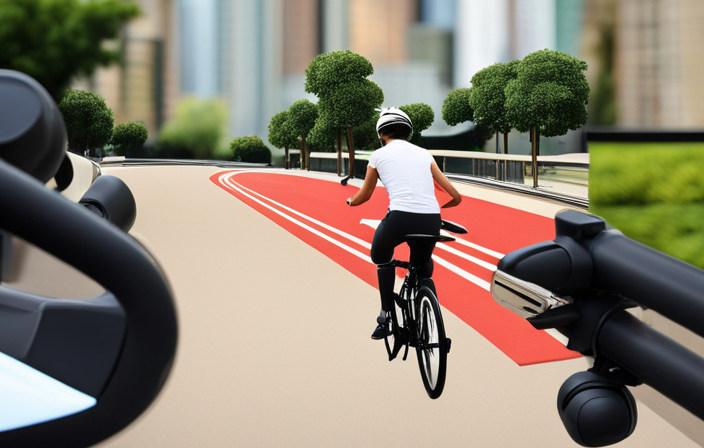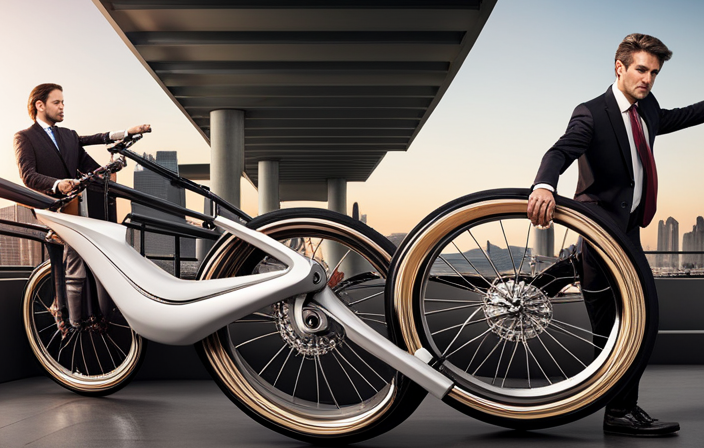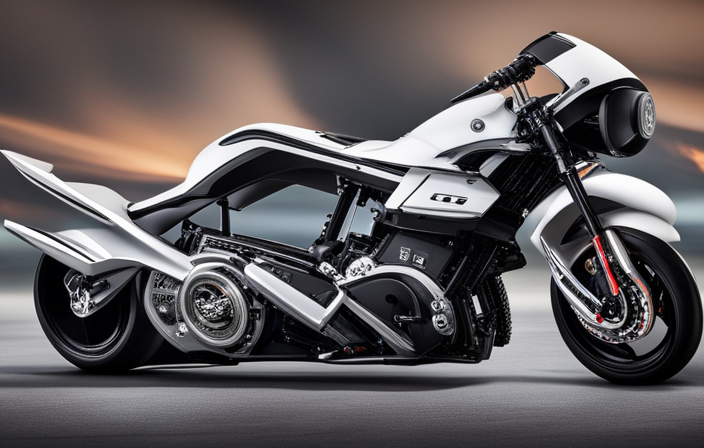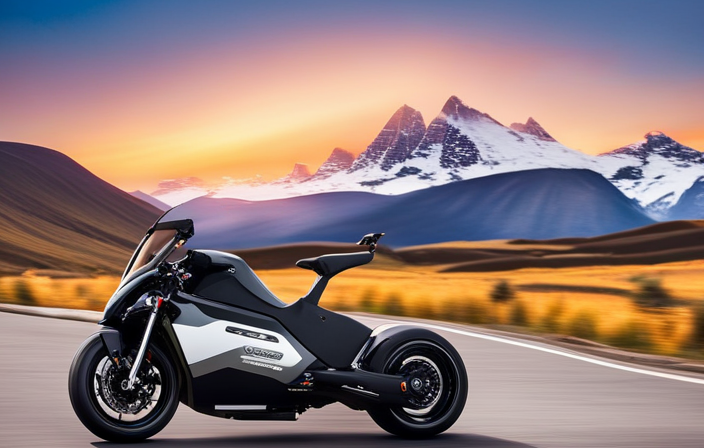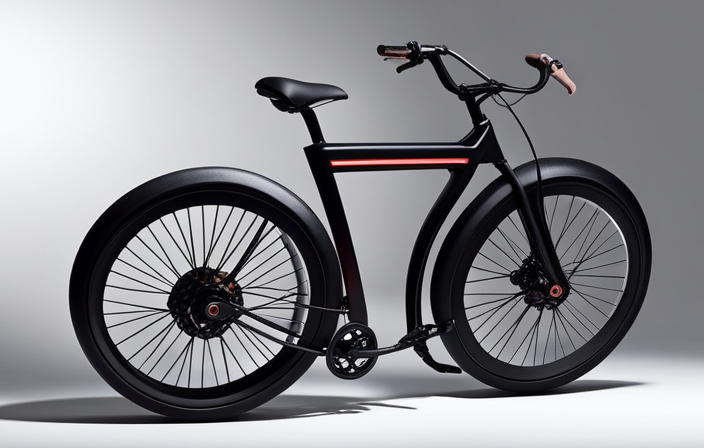Riding an electric bike is like unlocking a hidden power within yourself, effortlessly propelling you forward with each pedal stroke. It’s a symphony of technology and precision, where the motor seamlessly amplifies your efforts, making even the steepest hills feel like a gentle breeze.
As someone who has experienced the exhilaration of gliding through city streets and exploring new horizons on an electric bike, I can assure you that it is not only easy, but also a transformative and empowering experience.
Let’s delve into the intricacies of riding an electric bike and uncover the ease and joy it brings.
Key Takeaways
- Electric bikes are easy to ride and have advanced technology.
- The motor provides assistance while pedaling, making it easier to ride uphill or against winds.
- Adjusting to the motor assistance by pedaling at a higher cadence and in a lower gear enhances the ride.
- Riding an electric bike is a transformative and empowering experience.
Introduction to Electric Bikes
Riding an electric bike is easy, as you’ll quickly discover once you hop on and start pedaling. Electric bike technology has come a long way, making it simpler than ever to ride one.
When choosing the right electric bike, there are a few key factors to consider. First, think about the type of riding you’ll be doing, whether it’s commuting, off-roading, or leisurely rides around town. Next, consider the battery capacity and range, as this will determine how far you can travel on a single charge. Additionally, think about the motor power and assist levels, which will affect the bike’s performance and how much effort you need to exert while riding.
Understanding these aspects will help you find the perfect electric bike for your needs.
Now, let’s delve into how electric bikes work and what sets them apart from traditional bicycles.
How Electric Bikes Work
Operating an e-bike involves understanding the functioning of its electrical components. Electric bike technology has advanced significantly in recent years, making these bikes more efficient and user-friendly. The heart of an electric bike is its battery, which powers the motor. The battery is typically lithium-ion and can be easily recharged using a standard electrical outlet. The motor, located in the hub of the bike’s wheel, provides assistance when pedaling, making it easier to ride uphill or against strong winds. This motor is controlled by a controller, which allows the rider to adjust the level of assistance provided. With the help of this electric bike technology, riders can effortlessly cover long distances and conquer challenging terrains. Understanding the motor assistance is essential for maximizing the advantages of electric bikes, which will be discussed in the subsequent section.
Understanding the Motor Assistance
Understanding how the motor assists is crucial for getting the most out of an e-bike. The motor power is what propels the bike forward and provides the extra boost that makes riding effortless. With a range of motor power options available, it’s important to choose one that suits your riding style and needs.
The acceleration control allows you to easily adjust the speed of the bike, whether you want a gentle cruise or a quicker ride. It’s like having your own personal assistant, giving you the perfect amount of power when you need it.
Now that we understand how the motor assists, let’s move on to the next section about getting started: mounting and dismounting, where we’ll explore the proper techniques for getting on and off the e-bike seamlessly.
Getting Started: Mounting and Dismounting
To begin your journey on an e-bike, it’s important to learn the proper techniques for mounting and dismounting. Here are three key tips to ensure a smooth start and finish to your ride:
-
Secure footing: Before mounting the bike, make sure you have a stable footing on the ground. Place one foot on the pedal in the lowest position and the other foot on the ground for balance.
-
Smooth mounting: To mount the e-bike, push off with your foot on the ground and swing your other leg over the seat. As you do this, apply gentle pressure on the pedal to engage the motor assistance smoothly.
-
Controlled dismount: When it’s time to dismount, slow down and come to a complete stop before getting off the bike. Use the same technique as mounting, swinging your leg over the seat and placing your feet firmly on the ground.
With these mounting techniques and dismounting tips mastered, you’re ready to move on to the next section about riding techniques and safety tips.
Riding Techniques and Safety Tips
Start by familiarizing yourself with the proper riding techniques and safety tips to ensure a smooth and enjoyable experience on your e-bike. When it comes to riding an electric bike, understanding the correct riding positions is crucial. Make sure to maintain an upright posture, with your back straight and your shoulders relaxed. This will help you maintain control and balance while riding. Additionally, be mindful of your braking techniques. Electric bikes typically have powerful brakes, so it’s important to apply them gradually and evenly to avoid sudden stops or skidding. Practice using both the front and rear brakes together for optimal control.
Transitioning into the next section about adjusting to the motor assistance, it’s important to note that mastering these riding techniques and safety tips will set a solid foundation for your e-bike journey.
Adjusting to the Motor Assistance
Once you’re comfortable with the riding techniques, you’ll quickly adapt to the motor assistance on your e-bike. The motor assistance benefits are truly remarkable. It provides an extra boost of power that makes riding uphill or against the wind a breeze.
You’ll feel the difference as soon as you engage the motor, effortlessly gliding along the road. However, it’s important to adjust your riding style to fully maximize the benefits of the motor assistance. You’ll find that you can pedal at a higher cadence and in a lower gear, allowing the motor to do most of the work. This will not only make your ride more enjoyable, but it will also extend the battery life of your e-bike.
It’s all about finding the right balance between pedal power and motor assistance. As we move on to navigating different terrain and road conditions, you’ll discover how to make the most of your e-bike’s capabilities.
Navigating Different Terrain and Road Conditions
Navigating different types of terrain and road conditions can be a challenge, but with the motor assistance on your e-bike, you’ll have the confidence to tackle any obstacles in your path.
The off-road capabilities of an electric bike are impressive. Whether you’re riding on muddy trails, sandy beaches, or rocky terrain, the motor power will help you maintain stability and control. With the ability to easily switch between power modes, you can adjust the motor assistance based on the terrain you’re riding on.
Additionally, e-bikes are designed to handle various weather conditions. From rainy days to snowy winters, the electric motor ensures a smooth and stable ride.
As we move into discussing battery life and charging, it’s important to note that the motor assistance on an e-bike is a key factor in optimizing battery efficiency and extending your ride time.
Battery Life and Charging
To maximize your riding time, it’s important to understand the battery life and charging process of your e-bike.
The battery life of an electric bike can vary depending on various factors such as the terrain, rider weight, and level of assistance used. On average, most e-bike batteries can provide a range of 40-80 miles on a single charge. However, it’s essential to note that battery life may decrease over time as the battery ages.
To ensure you have enough power for your rides, it’s advisable to plan your routes accordingly and be aware of charging stations along the way. Many cities now have dedicated charging stations where you can recharge your e-bike’s battery. By taking advantage of these stations, you can extend your riding time and explore further.
As we transition into the next section on maintenance and care for electric bikes, it’s important to keep in mind that proper charging practices can help prolong the life of your battery.
Maintenance and Care for Electric Bikes
Make sure you regularly clean and lubricate the chain of your e-bike to ensure smooth and efficient operation. This is one of the most important maintenance tips for electric bikes.
Dirt and grime can accumulate on the chain, causing it to wear out faster and affecting the overall performance of the bike. Use a degreaser and a brush to clean the chain, then apply a high-quality lubricant to keep it running smoothly.
Additionally, check the tire pressure regularly and make sure it is at the recommended level to prevent flats and ensure a comfortable ride.
Troubleshooting common issues such as brake adjustments, loose bolts, and battery maintenance are also essential for keeping your electric bike in top shape.
By maintaining your e-bike properly, you can enjoy the benefits of riding an electric bike with peace of mind.
Benefits of Riding an Electric Bike
Riding an e-bike offers numerous advantages, including increased efficiency and reduced carbon emissions. Electric bikes are a great way to commute or explore the outdoors while also improving mental well-being. The convenience and ease of riding an e-bike can help reduce stress and improve overall mood. Additionally, electric bikes are environmentally friendly, as they produce zero emissions and contribute to reducing our carbon footprint.
To illustrate the benefits of riding an electric bike, consider the following table:
| Benefits of Riding an Electric Bike |
|---|
| Increased efficiency |
| Reduced carbon emissions |
| Improved mental well-being |
By riding an e-bike, you can not only improve your own well-being but also contribute to a greener and cleaner environment. The next section will delve into the topic of improving fitness and health through electric bike riding.
Improving Fitness and Health
Improving fitness and health can be achieved through regular use of an e-bike. Riding an electric bike provides a great cardiovascular workout, helping to improve heart health and increase stamina. The pedal-assist feature allows riders to choose their desired level of exertion, making it suitable for all fitness levels.
In addition, the resistance from pedaling uphill and against strong winds helps to burn calories and promote weight loss. The continuous movement of the legs while riding an e-bike also helps to tone and strengthen leg muscles. Moreover, the low-impact nature of electric biking reduces strain on joints, making it a suitable exercise option for individuals with joint issues.
Transitioning to the subsequent section, an e-bike not only benefits personal fitness but also serves as an eco-friendly transportation option.
Eco-Friendly Transportation Option
Transitioning to the subsequent section, an e-bike also serves as a green transportation choice, reducing carbon emissions and promoting environmental sustainability.
E-bikes are considered an eco-friendly transportation option due to their electric motor that assists with pedaling, reducing the need for fossil fuel consumption. By using an e-bike instead of a car for short trips, individuals can significantly decrease their carbon footprint and contribute to a cleaner environment.
Additionally, e-bikes provide health benefits as they encourage physical activity and exercise, leading to improved cardiovascular fitness and weight management. Riding an e-bike can also reduce stress levels and improve mental well-being.
As we delve into the topic of cost savings compared to traditional bikes and cars, it becomes evident that e-bikes offer a sustainable and efficient mode of transportation.
Cost Savings Compared to Traditional Bikes and Cars
Moving on from the eco-friendly benefits of electric bikes, let’s now discuss the cost savings they offer in comparison to traditional bikes and cars.
When considering the overall cost, electric bikes prove to be a cost-effective transportation option. Here is a breakdown of the cost comparison:
-
Purchase Price: Electric bikes are typically more expensive upfront compared to traditional bikes, but they are significantly cheaper than cars.
-
Maintenance: Electric bikes require less maintenance compared to cars, reducing overall costs.
-
Fuel and Charging: Electric bikes are powered by electricity, which is cheaper compared to gasoline or diesel used by cars.
-
Environmental Impact: Electric bikes have a much lower environmental impact compared to cars, contributing to a greener and cleaner environment.
With these cost savings and environmental advantages, electric bikes offer a compelling alternative to traditional bikes and cars.
Now, let’s delve into exploring new routes and destinations.
Exploring New Routes and Destinations
Discovering new routes and destinations with an electric bike allows you to expand your horizons and experience the thrill of exploring unfamiliar places. The electric bike’s ability to effortlessly navigate different terrains opens up a world of possibilities for adventure seekers.
Whether it’s exploring hidden gems tucked away in the countryside or finding scenic routes along the coast, the electric bike provides an exhilarating way to discover the beauty of nature. With its efficient motor and long-lasting battery, you can confidently venture further and explore more without worrying about running out of energy.
As you uncover new routes and destinations, you’ll also have the opportunity to connect with other electric bike enthusiasts, sharing stories and experiences. Joining the electric bike community opens doors to endless possibilities for exploration and connection.
Joining the Electric Bike Community
If you’re looking to expand your social circle and connect with like-minded individuals, joining the electric bike community is a fantastic way to do so. Not only will you have the opportunity to meet fellow electric bike enthusiasts, but you can also tap into a wealth of knowledge and resources. One way to get involved is by finding local electric bike groups in your area. These groups often organize group rides, events, and workshops where you can learn more about electric bike accessories and maintenance. Additionally, joining these groups can provide you with access to exclusive discounts and deals on electric bike gear. By connecting with the electric bike community, you can enhance your riding experience and build lasting friendships with people who share your passion for electric bikes.
| Benefit | Explanation |
|---|---|
| Access to Knowledge | Learn more about electric bike accessories and maintenance |
| Networking Opportunities | Connect with like-minded individuals and share experiences |
| Exclusive Discounts | Gain access to special deals on electric bike gear |
Frequently Asked Questions
Are electric bikes allowed on bike paths and trails?
Yes, electric bikes are generally allowed on bike paths and trails. However, it is important to be aware of safety concerns, such as the increased speed and potential for collisions with pedestrians and other cyclists on these public roads.
Can I ride an electric bike in the rain?
Riding an electric bike in the rain can be done, but precautions must be taken. Wear waterproof clothing and consider adding fenders to prevent water splashes. Slow down and be cautious of slippery surfaces.
How long does it take to charge an electric bike battery?
Charging time for electric bike batteries can vary depending on the model and capacity, ranging from 3 to 6 hours. It’s important to note that battery life is influenced by factors like terrain, speed, and rider weight.
Are electric bikes more expensive to maintain than traditional bikes?
Electric bikes are generally more expensive to maintain than traditional bikes due to their complex electrical components. The cost comparison includes battery replacements, motor maintenance, and specialized repairs. Regular maintenance requirements for electric bikes are also higher.
Can I ride an electric bike without pedaling?
Yes, you can ride an electric bike without pedaling, thanks to the throttle feature. However, it’s important to note that pedaling while riding uphill not only conserves battery life but also provides health benefits and a more efficient ride.
Conclusion
In conclusion, riding an electric bike is an exhilarating experience that is both effortless and efficient. With its motor assistance and easy-to-use controls, you can effortlessly navigate through various terrains.
The eco-friendly nature of electric bikes not only benefits the environment but also saves you money on fuel expenses. Moreover, joining the electric bike community opens up a world of new routes and destinations to explore.
So hop on an electric bike today and embark on an exciting journey of pedal-powered passion and pleasure!
